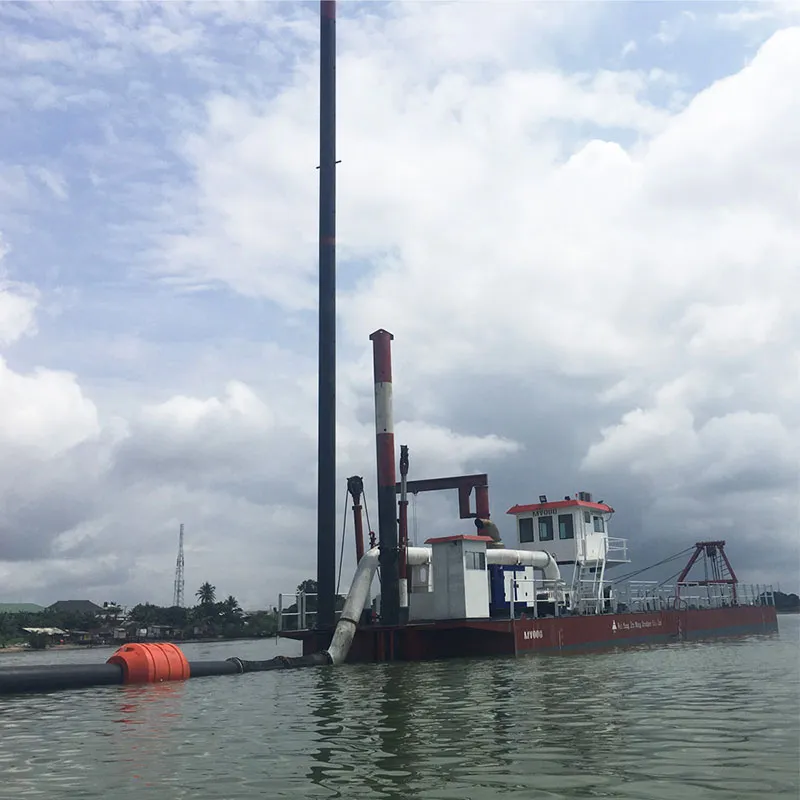How does a cutter suction dredger work?
2024-10-11
A cutter suction dredger (CSD) is a type of dredging vessel used to excavate and remove material from waterbeds, such as sand, clay, or rock, for purposes like deepening channels, land reclamation, or coastal protection. The cutter suction dredger combines two primary functions: cutting and suction. It is widely used for dredging in rivers, lakes, and coastal areas. Here's how it works:

Key Components of a Cutter Suction Dredger:
1. Cutter Head:
- The cutter head is a rotating, toothed device located at the front of the suction pipe. It is designed to loosen or break up hard material on the seabed or riverbed, such as sand, clay, gravel, or even rock.
2. Suction Pipe:
- Attached behind the cutter head, the suction pipe transports the loosened material (dredged slurry) from the seabed to the dredger. The pipe is connected to a powerful suction pump on the dredger.
3. Dredge Pump:
- The dredge pump creates the suction force needed to transport the mixture of water and dredged material (slurry) through the pipe. The pump is a high-capacity system designed to move large quantities of material efficiently.
4. Spud System:
- Spuds are large poles or anchors that are hydraulically operated to secure the dredger to the seabed during dredging operations. This system allows the dredger to stay in position while cutting and dredging material.
5. Swinging Winches:
- The dredger is equipped with swinging winches attached to anchors or spuds that help move the cutter head in a horizontal arc. This allows the cutter head to sweep across the dredging area to remove material in an efficient manner.
6. Discharge Pipeline:
- The dredged material, once sucked up, can be transported through a discharge pipeline to a designated location, such as a spoil area on land or to a nearby barge for transport.
How a Cutter Suction Dredger Works:
1. Positioning the Dredger:
- The dredger is positioned at the dredging site using its spud system. The rear spud (main spud) is lowered to the seabed to fix the dredger in place, while the front spud (or spud carriage) allows the vessel to pivot.
2. Cutting the Material:
- The cutter head, which is mounted at the front of the dredger, is lowered to the seabed. The rotating cutter head is equipped with sharp teeth or blades that cut, grind, or dislodge hard material, such as soil, rock, or sediment, from the seabed.
3. Suction of Material:
- As the cutter head loosens the material, the suction pump draws in the water-material mixture (slurry) through the suction pipe. The dredge pump, which is located on the dredger, creates the necessary suction to lift the slurry from the seabed.
4. Swinging Motion:
- The cutter head moves in a sweeping, side-to-side motion, creating a trench or widening an area. This swinging motion is controlled by winches and cables that anchor the dredger to the sides of the dredging site.
5. Transporting the Dredged Material:
- The slurry is pumped through the discharge pipeline, either directly to a dumping site onshore or into barges for further transport. The discharge pipeline can be floating, submerged, or extend over land depending on the dredging project.
6. Advancing the Dredger:
- Once a section is dredged, the cutter suction dredger is moved forward by shifting its spuds. The front spud is raised, and the dredger pivots around the rear spud. After advancing, the front spud is lowered again to secure the new position, and the dredging process continues.
Applications of Cutter Suction Dredgers:
- Land Reclamation: Dredged material is often used to create new land or restore eroded coastal areas.
- Harbor and Channel Deepening: CSDs are employed to deepen navigation channels for larger vessels.
- Mining: Used in underwater mining projects to extract valuable materials, like sand or gravel.
- Infrastructure Projects: CSDs are used in the construction of ports, dams, and other marine infrastructure projects.
Advantages of Cutter Suction Dredgers:
- Versatility: CSDs can handle a wide variety of materials, from soft sediment to harder soils and rock.
- Continuous Operation: These dredgers can work continuously without the need for pauses to collect material, making them highly efficient.
- Long-Distance Discharge: They can transport dredged material over long distances through pipelines, eliminating the need for additional transport by trucks or ships.
Limitations:
- Limited Mobility: Since CSDs are fixed in place during dredging, they are not as mobile as other types of dredgers, like trailing suction hopper dredgers.
- Environmental Impact: The cutting action can disturb the seabed, potentially harming marine ecosystems and creating turbidity (cloudiness in the water).
In summary, a cutter suction dredger is a powerful machine used for various dredging tasks, particularly when precision and the ability to handle tough materials are required. It cuts into the seabed, sucks up the loosened material, and transports it to a designated location, making it an essential tool in many marine and construction projects.


